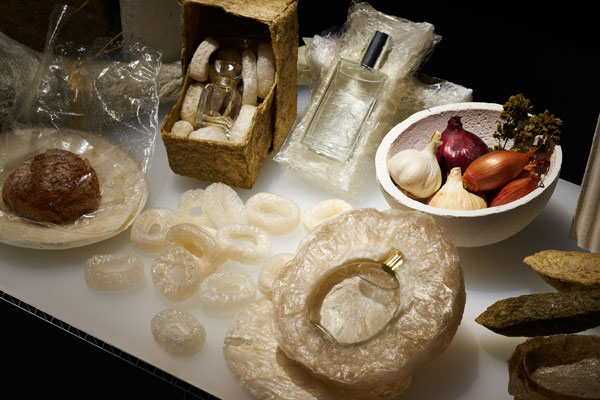Three Japanese designers walk into a supermarket—and no, this isn’t the beginning of a joke—to find themselves stopped at an item they had walked by many times before. The product that caused pause is agar, a seaweed-derived food product frequently eaten in Japan and also used in the scientific and medical fields worldwide. The three designers, Kosuke Araki, Noriaki Maetani, and Akira Muraoka, “were attracted by its material quality.” Agar has a porous, feathery structure and is very light despite its volume, which makes it an interesting option for a plastic alternative.

Kosuke Araki, Noriaki Maetani, and Akira Muraoka make up AMAM and studied together at the Product Design Department at Tama Art University. PHOTO: COURTESY OF LEXUS INTERNATIONAL
According to Muraoka, he and his friends had long been concerned about the energy used to produce packaging materials as well as recycle them. Boiling specific kinds of red algae and then dehydrating the broth and collecting the residue can produce agar with minimal energy. Plus, agar is also completely biodegradable. Due to its low production cost, energy requirements, and almost zero environmental impact, it seemed to be the perfect material for this young trio to explore.
Araki, Maetani and Muraoka studied together at the Product Design Department at Tama Art University and later formed AMAM, a name conceived from the combination of each of their names. Together, they came up with the idea for Agar Plasticity—dubbed “an ongoing material research project”—and submitted their design proposal for agar as a substitute to synthetic plastics to the 2016 Lexus Design Award.
 Fast forward, and AMAM was one of 12 finalists chosen to develop a prototype with support from a seasoned and internationally renowned designer. After their mentorship period with British designer Max Lamb, AMAM was chosen as this year’s Lexus Design Grand Prix winner. “This is a bold and ambitious experiment, which aims to address one of the biggest pollution problems of our time,” says Alice Rawsthorn, a British design critic and one of the competition’s judges. “The designers have made tremendous progress during the course of the award cycle, particularly in devising a wide range of possible practical applications for the material. Their success in doing so gives us confidence in their ability to tackle the many challenges and complexities they will face in continuing the development of the project.”
Fast forward, and AMAM was one of 12 finalists chosen to develop a prototype with support from a seasoned and internationally renowned designer. After their mentorship period with British designer Max Lamb, AMAM was chosen as this year’s Lexus Design Grand Prix winner. “This is a bold and ambitious experiment, which aims to address one of the biggest pollution problems of our time,” says Alice Rawsthorn, a British design critic and one of the competition’s judges. “The designers have made tremendous progress during the course of the award cycle, particularly in devising a wide range of possible practical applications for the material. Their success in doing so gives us confidence in their ability to tackle the many challenges and complexities they will face in continuing the development of the project.”
The theme of this year’s Lexus Design Award was “anticipation: anticipating the needs of people and society.” AMAM decided to consider agar as a sustainable raw material because to them “anticipating effective and sustainable utilization of natural resources has become more and more indispensable,”Muraoka says. Agar isn’t the only material being explored as a plastic alternative, as other companies are exploring biodegradable substances like mushrooms to replace plastic packaging. Agar, however, is propelling into exciting, uncharted territory. “No one has ever explored the possibility of agar as a plastic material, so there are a lot of things unknown,” Muraoka says.
“When we imagine what kind of future we would like to live in, we’ve thought that we shouldn’t ignore the social problems happening today,” he continues. “We instinctually thought about solving social problems, and we hope our work will reduce the garbage in the world. Agar Plasticity is our investigation into the potential for agar to replace plastics.” Their product is now well on its way to making AMAM’s vision of the future a reality thanks to the support of Lexus. As Yoko Okazawa, group manager of Lexus International says, “AMAM anticipates the future with a visionary solution to replace plastics by a sustainable material and therefore create a better world for generations to come.”
Download a PDF of this story here.

